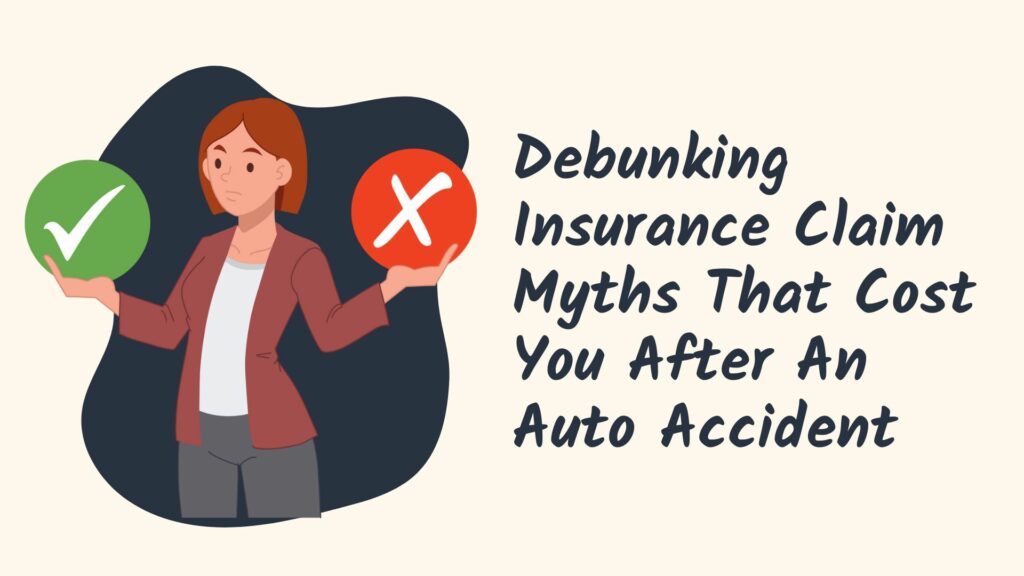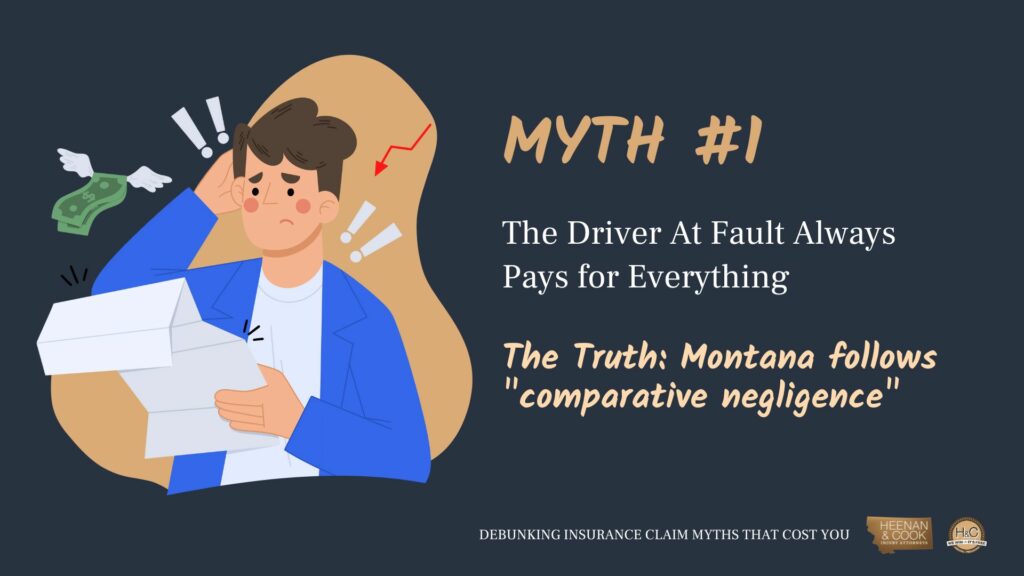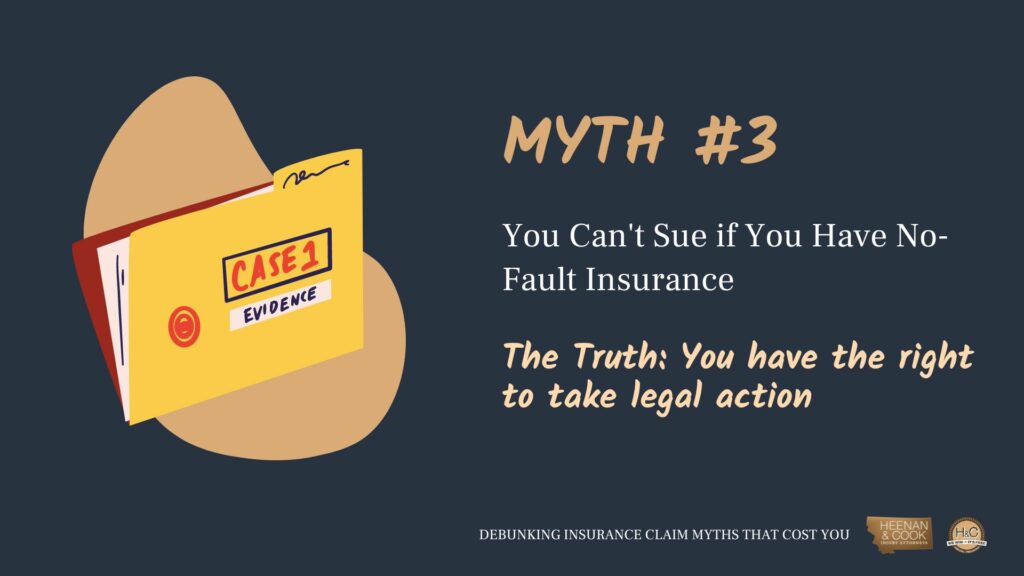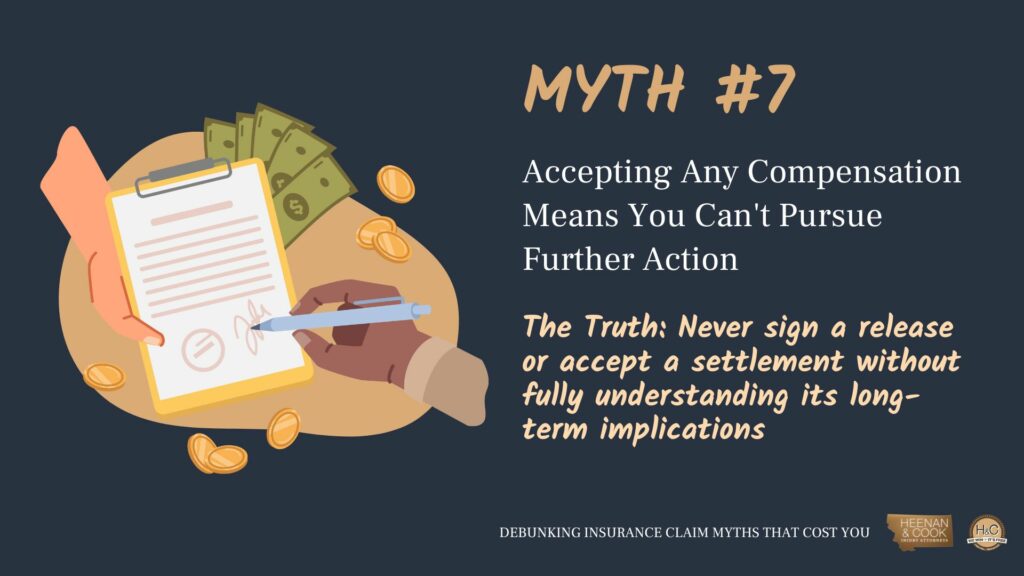Posted in Accident Data on March 17, 2024
Every year, Montana’s roads witness thousands of car accidents, some with life-altering consequences. In fact, there were over 20,000 crashes reported in Montana in 2022. Sadly, Montana’s fatality rate per capita is higher than many other states based on U.S. Department of Transportation’s report, underscoring the seriousness of accidents in our state.
Imagine one minute you’re driving down a familiar road on a clear day, and the next, everything changes in a crash. Suddenly, you’re thrown into the confusing world of insurance claims, filled with misunderstandings and myths. These false ideas can hurt your chances of getting the help you deserve.
From confusion about Montana’s laws to worries about filing a claim, it’s time to clear things up. This article will debunk those common myths and give you the straight facts you need to handle the aftermath of a Montana car accident.
Table of Contents
- Myth #1: The Driver At Fault Always Pays for Everything
- Myth #2: Accepting the First Insurance Settlement is Always the Best Option
- Myth #3: You Can’t Sue if You Have No-Fault Insurance
- Myth #4: You Have Plenty of Time to File a Claim After an Accident
- Myth #5: If the Other Driver Doesn’t Have Insurance, You Can’t Get Compensation
- Myth #6: Sharing Your Medical History with the Insurance Company is Required
- Myth #7: Accepting Any Compensation Means You Can’t Pursue Further Action
- Myth #8: You Don’t Need a Lawyer for a Minor Accident
- Get Legal Representation
Myth #1: The Driver At Fault Always Pays for Everything
Many people think that if they’re in a car accident and they’re even slightly at fault, they won’t be able to get any compensation for their injuries or damages.
The Truth: Montana follows “comparative negligence”
Don’t be fooled! This common myth can cost you money. Here’s how it really works in Montana:
- Comparative Negligence: This means that even if you made a mistake that contributed to the accident, you might still be able to get compensation. The amount you receive will be reduced based on your percentage of fault.
- Example: Say you were in an accident, and you were found to be 20% at fault. Your total medical bills and car repairs come to $10,000. In this case, you could still potentially receive $8,000 from the other driver’s insurance company.
Why this matters:
- Don’t admit total fault: Even if you think you were partly to blame, never admit full responsibility at the scene. Insurance companies will try to use this against you.
Get legal help: A lawyer is essential for determining how much you were at fault. They’ll fight to make sure the other drivers involved pay their fair share.
Myth #2: Accepting the First Insurance Settlement is Always the Best Option
After an accident, you might be eager to put the whole experience behind you. Insurance companies know this and may offer you a quick settlement. But beware – accepting the first offer is rarely in your best interest.
Why you shouldn’t rush
- Insurance companies want to save money: Their goal is to minimize payouts. That initial offer likely won’t cover all your needs, especially long-term costs.
- Hidden expenses: Medical bills, car repairs, lost income from missing work – these add up quickly. It’s hard to know the true cost of your accident right away.
A lawyer protects your rights: A lawyer understands the full value of your claim. They’ll negotiate fiercely with the insurance company to get you the compensation you truly deserve.
Myth #3: You Can’t Sue if You Have No-Fault Insurance
The term “no-fault” can be misleading. While Montana has a system with some no-fault aspects, it doesn’t mean you always give up your right to take legal action. Let’s break it down:
How “No-Fault” Works in Montana
- Initial Coverage: After an accident, your own insurance company (regardless of who was at fault) will pay up to a certain amount for your immediate medical bills and some other expenses. This is the “no-fault” part.
- Example: Let’s say you have a minor accident. Your no-fault insurance would likely cover your initial doctor’s visit and any car repairs, saving you the hassle of dealing with the other driver’s insurance directly.
When You CAN Sue in Montana
Despite the no-fault elements, you still have the right to sue the at-fault driver in these situations:
- Serious Injuries: If your injuries are severe or lead to long-term disability, you can sue for damages that exceed your no-fault coverage.
- Expensive Treatment: If your medical bills go beyond your insurance limits, you can seek additional compensation from the at-fault driver.
- Reckless Behavior: If the other driver was driving drunk, speeding excessively, or engaging in other reckless behavior, you can sue them regardless of the extent of your injuries.
Why it Matters
Understanding your rights is crucial after a serious accident. Don’t let the term “no-fault” trick you into thinking you can’t seek full compensation. A lawyer will help you navigate Montana’s laws and fight for the outcome you deserve.
Myth #4: You Have Plenty of Time to File a Claim After an Accident
Don’t fall into the trap of procrastination! Montana has strict deadlines for filing lawsuits after a car accident, and missing these deadlines could cost you everything.
The Truth About Time Limits
- Statute of Limitations: In Montana, you generally have three years from the date of the accident to file a personal injury lawsuit related to the crash. There are some exceptions, but this three-year window applies in most cases.
- Why delays are dangerous: The longer you wait, the harder it may be to gather evidence, track down witnesses, and build a strong case. Insurance companies might also be less willing to negotiate fairly.
Importance of Quick Action
- Preserve evidence: Critical evidence, like photos of the scene or damage to your car, could be lost over time. Acting quickly gives you the best chance to document what happened.
Protect your rights: The sooner you start the process, the more time you and your lawyer have to prepare a strong claim or lawsuit.
Myth #5: If the Other Driver Doesn’t Have Insurance, You Can’t Get Compensation
Many people wrongly believe they’re out of luck if they are in an accident with an uninsured driver. Luckily, there is a solution that can protect you from this scenario.
The Power of Uninsured/Underinsured Motorist Coverage (UM/UIM)
- Your Safety Net: This type of coverage is part of your own auto insurance policy. It kicks in to compensate you if:
- The other driver is uninsured and at fault.
- The other driver is underinsured (their coverage isn’t enough to pay for your damages)
- Example: Say you’re seriously injured by an uninsured driver and have $50,000 in medical bills. Your UM coverage could potentially step in to cover those costs.
Why this Matters
- Unfortunately Common: A significant number of drivers on the road are uninsured. Don’t leave yourself financially vulnerable if they cause an accident.
- Peace of Mind: UM/UIM coverage provides peace of mind, knowing that you’ll be protected even if the worst-case scenario happens.
Important Note: In Montana, uninsured motorist coverage is mandatory, but underinsured motorist coverage is optional. It’s wise to speak with your insurance agent to make sure you have both!
Myth #6: Sharing Your Medical History with the Insurance Company is Required
Insurance companies might try to pressure you to sign broad medical releases after an accident. Don’t be fooled – you have more control over your health records than you might think.
The Truth About Medical Records
- Relevance is key: You are only obligated to release medical records directly related to injuries sustained in the accident you’re making a claim for.
- Insurance company tactics: Insurers might try to dig into your past medical history to find unrelated conditions to blame for your current problems. Don’t fall for this!
- Protecting your privacy: A lawyer can help you understand what information is truly necessary to share and make sure the insurance company isn’t overstepping its boundaries.
Why this Matters
- Prevent unfair reductions: Issues from years ago shouldn’t reduce the compensation you deserve for injuries caused by a recent accident.
Preserve your rights: Don’t give the insurance company more ammunition than absolutely necessary, especially when it comes to your private medical information.
Myth #7: Accepting Any Compensation Means You Can’t Pursue Further Action
Insurance companies might try to pressure you into accepting a quick settlement offer, especially shortly after a crash. They might make it seem like signing a release and taking an initial check is the best way to move on. Beware – this could be a costly mistake.
The Truth About Settlement Releases
- Read the fine print: Settlement releases often include language that waives your right to sue or seek further compensation, even if you discover new injuries or face unexpected costs later on.
- Hidden consequences: The full extent of your injuries and their long-term impact might not be clear immediately after the accident. Accepting a low settlement early on could leave you responsible for huge medical bills down the road.
- Maximizing your recovery: A lawyer’s job is to make sure you are not only compensated for your current needs but for any potential future costs stemming from the accident.
Why this Matters
- Don’t shortchange yourself: Insurance companies aim to save money, not ensure your full recovery. A hasty settlement could leave you paying out-of-pocket for expenses that should be covered.
Protect your future: Never sign a release or accept a settlement without fully understanding its long-term implications. Legal advice is crucial!
Myth #8: You Don’t Need a Lawyer for a Minor Accident
Don’t underestimate the impact of a “minor” accident. Even what initially seems like a fender bender can have lasting consequences.
- Hidden injuries: Some injuries, like whiplash, might not show symptoms right away. A few days later, you could be dealing with serious pain and expensive medical bills.
- Insurance disputes: Even in seemingly straightforward accidents, insurance companies might try to deny your claim or downplay the severity of your situation.
- Protecting your future: A lawyer ensures that you’re compensated fully, not just for immediate costs, but for potential long-term needs related to the accident.
The Importance of Legal Representation
Having a lawyer by your side after a Montana car accident offers numerous benefits:
- Handling the paperwork and hassle: Lawyers deal with insurance companies on your behalf, so you can focus on recovery.
- Understanding your rights: Legal complexities can be overwhelming. A lawyer ensures you are treated fairly throughout the claims process.
- Maximizing your compensation: Lawyers calculate the true value of your injuries and losses, fighting for the maximum settlement you deserve.
- Peace of mind: Knowing a professional is advocating for you gives peace of mind during a stressful time.
Been in a Montana Car Accident? Don’t Navigate the Claims Process Alone
If you’ve been in a Montana car accident, the aftermath can be confusing and overwhelming. Insurance companies might try to rush you into a settlement or downplay your injuries. Don’t let them take advantage of you.
Heenan & Cook understand how difficult this time can be, and we’re here to help. Get the experienced guidance you need now to ensure you receive the full compensation you deserve. Contact us today for a free consultation and let us fight for your rights.











